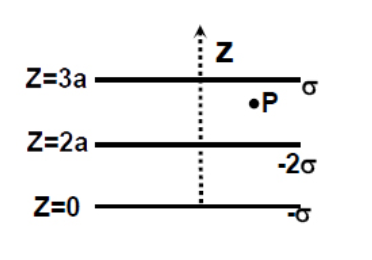
Three infinitely charged sheets are kept parallel to x-plane having charge densities as shown. Then, the value of the electric field at 'P' is

A. $\dfrac{{ - 4\sigma }}{{{\varepsilon _0}}}\hat k$
B. $\dfrac{{4\sigma }}{{{\varepsilon _0}}}\hat k$
C. $\dfrac{{ - 2\sigma }}{{{\varepsilon _0}}}\hat k$
D. $\dfrac{{2\sigma }}{{{\varepsilon _0}}}\hat k$

Answer
580.5k+ views
Hint: For an infinitely charged plane sheet, electric field is given by $E = \dfrac{\sigma }{{2{\varepsilon _0}}}$ .
The total electric field at point ‘$P$’ will be the vector sum of the electric field due to all the three infinitely charged sheets.
Complete answer:
As given in the question, three infinitely charged sheets are kept parallel to x-plane or are kept at $z=0, z=2a$, and $z=3a.$
For an infinite sheet of charge, the electric field will be perpendicular to the surface and given by $E = \dfrac{\sigma }{{2{\varepsilon _0}}}$. This formula is derived by the Gauss Law which states that the total electric flux out of a closed surface is equal to the charge enclosed divided by the permittivity. The electric flux in an area is defined as the electric field multiplied by the area of the surface projected in a plane and perpendicular to the field.
Now, the direction of the electric field depends on the sign of surface charged density $\sigma $ and the location of the point $P$. If $\sigma $ is positive then the direction will be towards point $P$.
Let us suppose an upward direction to be positive.
So, the electric field due to the sheet at $z=0$, ${E_{ - \sigma }} = - \dfrac{\sigma }{{2{\varepsilon _0}}}$
Similarly, the electric field due to the sheet at $z=2a$, ${E_{ - 2\sigma }} = - \dfrac{{2\sigma }}{{2{\varepsilon _0}}}$.
And, the electric field due to the sheet at $z=3a$, ${E_\sigma } = - \dfrac{\sigma }{{2{\varepsilon _0}}}$
Now, the total electric field due to the sheets at point P is given by, ${E_P} = {E_{ - \sigma }} + {E_{ - 2\sigma }} + {E_\sigma }$ as a vector sum.
So, ${E_P} = - \dfrac{\sigma }{{2{\varepsilon _0}}} - \dfrac{{2\sigma }}{{2{\varepsilon _0}}} - \dfrac{\sigma }{{2{\varepsilon _0}}}$
On simplification we have, ${E_P} = - \dfrac{{2\sigma }}{{{\varepsilon _0}}}$
Here (–) sign represents the downward or opposite of $\hat k$.
$\therefore$ The the value of electric field at 'P' is ${E_P} = - \dfrac{{2\sigma }}{{{\varepsilon _0}}}$. Hence, the correct option is (C).
Note:
The electric field is a vector quantity. So, carefully determine the direction of the field. Remember that the direction of the electric field depends on the sign of surface charge density $\sigma $ and the location of the point P. If $\sigma $ is positive then the direction will be towards point $P$ and if it is negative then the direction will be away from point $P$.
The total electric field at point ‘$P$’ will be the vector sum of the electric field due to all the three infinitely charged sheets.
Complete answer:
As given in the question, three infinitely charged sheets are kept parallel to x-plane or are kept at $z=0, z=2a$, and $z=3a.$
For an infinite sheet of charge, the electric field will be perpendicular to the surface and given by $E = \dfrac{\sigma }{{2{\varepsilon _0}}}$. This formula is derived by the Gauss Law which states that the total electric flux out of a closed surface is equal to the charge enclosed divided by the permittivity. The electric flux in an area is defined as the electric field multiplied by the area of the surface projected in a plane and perpendicular to the field.
Now, the direction of the electric field depends on the sign of surface charged density $\sigma $ and the location of the point $P$. If $\sigma $ is positive then the direction will be towards point $P$.
Let us suppose an upward direction to be positive.
So, the electric field due to the sheet at $z=0$, ${E_{ - \sigma }} = - \dfrac{\sigma }{{2{\varepsilon _0}}}$
Similarly, the electric field due to the sheet at $z=2a$, ${E_{ - 2\sigma }} = - \dfrac{{2\sigma }}{{2{\varepsilon _0}}}$.
And, the electric field due to the sheet at $z=3a$, ${E_\sigma } = - \dfrac{\sigma }{{2{\varepsilon _0}}}$
Now, the total electric field due to the sheets at point P is given by, ${E_P} = {E_{ - \sigma }} + {E_{ - 2\sigma }} + {E_\sigma }$ as a vector sum.
So, ${E_P} = - \dfrac{\sigma }{{2{\varepsilon _0}}} - \dfrac{{2\sigma }}{{2{\varepsilon _0}}} - \dfrac{\sigma }{{2{\varepsilon _0}}}$
On simplification we have, ${E_P} = - \dfrac{{2\sigma }}{{{\varepsilon _0}}}$
Here (–) sign represents the downward or opposite of $\hat k$.
$\therefore$ The the value of electric field at 'P' is ${E_P} = - \dfrac{{2\sigma }}{{{\varepsilon _0}}}$. Hence, the correct option is (C).
Note:
The electric field is a vector quantity. So, carefully determine the direction of the field. Remember that the direction of the electric field depends on the sign of surface charge density $\sigma $ and the location of the point P. If $\sigma $ is positive then the direction will be towards point $P$ and if it is negative then the direction will be away from point $P$.
Recently Updated Pages
Master Class 12 English: Engaging Questions & Answers for Success

Master Class 12 Economics: Engaging Questions & Answers for Success

Master Class 12 Social Science: Engaging Questions & Answers for Success

Master Class 12 Maths: Engaging Questions & Answers for Success

Master Class 12 Chemistry: Engaging Questions & Answers for Success

Master Class 12 Business Studies: Engaging Questions & Answers for Success

Trending doubts
What are the major means of transport Explain each class 12 social science CBSE

Which are the Top 10 Largest Countries of the World?

Draw a labelled sketch of the human eye class 12 physics CBSE

Explain sex determination in humans with line diag class 12 biology CBSE

The pH of the pancreatic juice is A 64 B 86 C 120 D class 12 biology CBSE

Explain sex determination in humans with the help of class 12 biology CBSE




